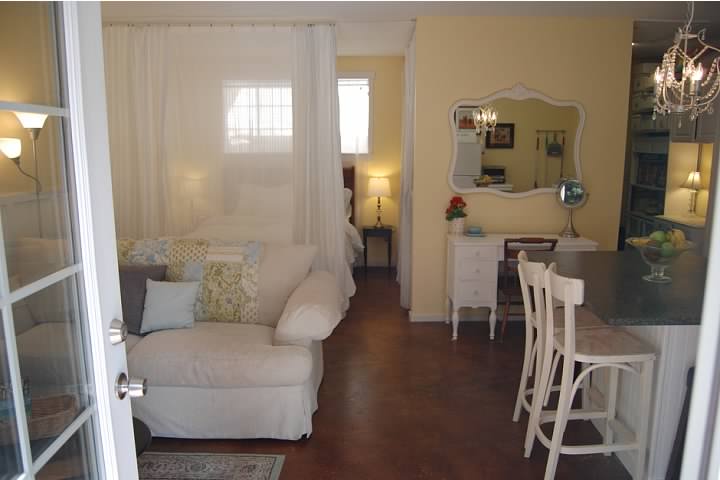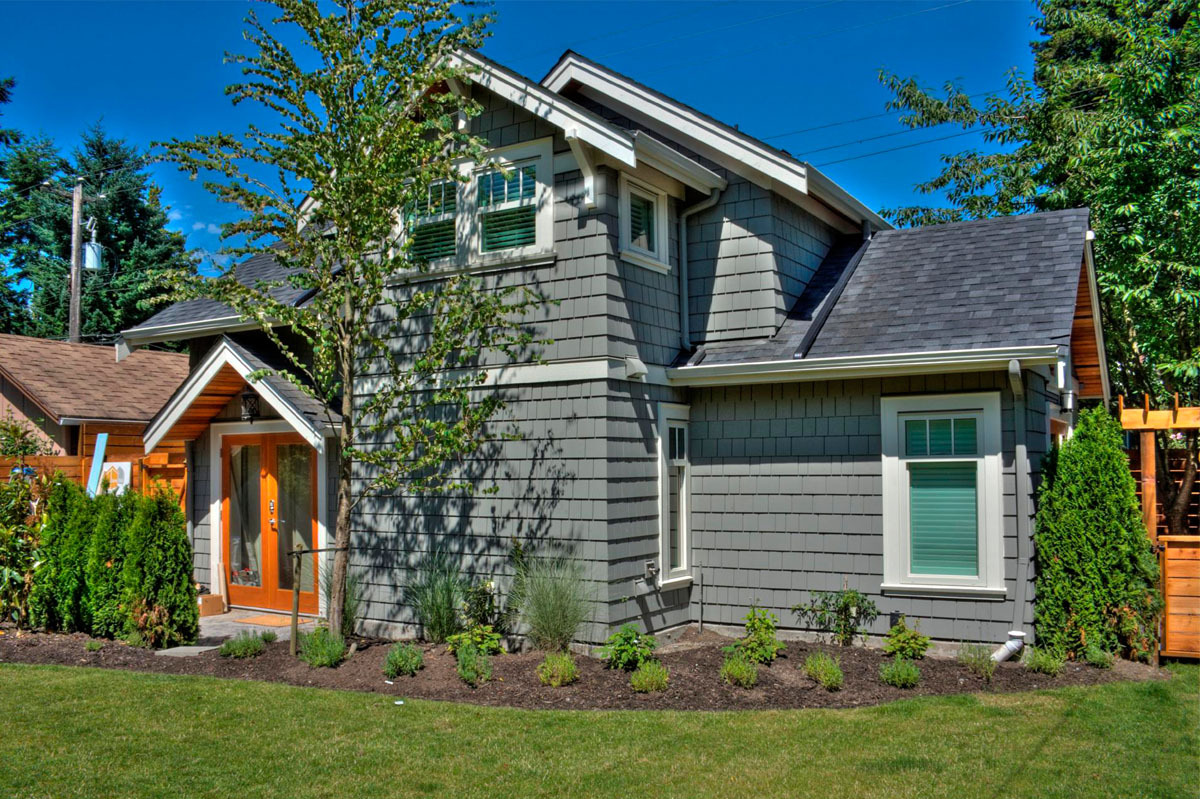Editor’s note July 2016: We’re bringing back this popular post to highlight the housing opportunities that ADUs—also known as in-law apartments or backyard cottages—could bring to growing cities. Why do ADUs still remain rare? Read on! For more information, check out our recent ADU article here.
———
Last time, we defined accessory dwelling units and told their story—how they spread so far and wide in Vancouver, BC. This time: their near-absence elsewhere in Cascadia.
Most other Cascadian cities appear to trail behind Vancouver, BC, in the ADU leagues. In British Columbia, Abbotsford, Kelowna and other cities have embraced ADUs with at least a portion of Vancouver’s conviction. The mid-sized city of New Westminster stands out in particular: it already had more than 2,400 ADUs a decade ago.
In the Northwest states, however, ADUs remain rare. Consider Portland, widely regarded as a US hotspot of miniature houses (so much so that there’s even a Portlandia-style spoof circulating online). Martin Brown, a small-house pioneer in Portland who has studied their real-estate value and maintains a field-leading website, surveyed his city’s records a few years ago. He looked for permitted accessory units and found, among 148,000 lots in eligible zones, just 431 actual secondary dwellings. That’s 0.3 percent of houses. The count, he guesses, may have risen to 500 or 600 by now, and he has elsewhere estimated that Portland has 2.5 times as many unpermitted as permitted ADUs. Still, altogether, they are likely found at little more than 1 percent of all single-family houses in Portland.
In Olympia, Washington, graduate student Travis Skinner emulated Brown’s methods for his thesis. He reported that homeowners got permits for just 53 ADUs in that city in the entire 15 year-period starting in 1995, when Olympia liberalized rules on secondary dwellings. As in Portland, Olympia’s unpermitted ADUs appear to outnumber permitted units by more than two to one, and as in Portland, Olympia likely has ADUs on about 1 percent of its single-family lots. Olympia is similar in population to New Westminster, yet it appears to have fewer than one-tenth as many ADUs.
Similar tallies of ADUs are unavailable for other cities in the Northwest states, even in big cities with large, professional planning departments like Seattle. But experts and planners across the region tend to view Portland as the leader in the Northwest states. That tells you something: in the Northwest, where ADUs are concerned, we’ve got a whole lot of nothing.

A garage converted into a living space: kitchen island, living room, and a bedroom behind a curtain by Royce Tillotson. (Used with permission.)
ADUs are not only dramatically more numerous in Vancouver, BC, than in other Cascadian cities; they are also multiplying more quickly. In Portland before 2010, the city was issuing permits for about 35 ADUs a year. By 2012, after the city waived ADU development fees and expanded the maximum legal size of units, the number had risen to around 150, according to Portland cottage developer Eli Spevak. Rebecca Esau of Portland’s Bureau of Development Services reports that by late 2010, ADUs were accounting for 6 percent of all new residences, a sixfold jump over previous years. (Of course, some of these units weren’t newly built but newly permitted: some illegal ADUs were coming in from the cold during the fee waiver.) Still, even 150 isn’t much compared with Vancouver’s 350 laneway house permits per year plus its more-numerous secondary suites.
Like what you're reading? Here's how Vancouver trounces the rest of Cascadia in building ADUs.
Seattle’s ADU-building pace is similar to Portland’s. Mike Podowski, land use policy manager for the Seattle Department of Planning & Development, says the city has been permitting between 100 and 175 attached ADUs a year, along with about 50 backyard cottages. In smaller cities, the pace is slower. It’s not even proportional to population. City planners in Bend and Eugene, Oregon, estimate that they issue 10 ADU permits a year; Gresham and Springfield issue about one a year. Yakima, Washington, wrote ADU rules more than three years ago, and not a single ADU application has yet arrived at city hall. These are not giant cities, of course, but they do have tens of thousands of residents. Even minuscule Whistler, BC, with fewer than 10,000 residents, was already building about 75 ADUs a year at last tally.
In Portland and Seattle, a year’s worth of new ADUs add up to an apartment building or two—a paltry sum. Elsewhere, ADUs amount to rounding errors in the housing column. What’s the hold up? It’s not the potential number of sites.
The Scale of the Opportunity
The potential of ADU construction in Cascadia is hard to overstate. Including British Columbia, Idaho, Oregon, and Washington, the region has 7 million houses, apartments, and other dwelling units, according to data from BCStats and the US Census Bureau. Some 60 percent of them are detached single-family homes on their own lots. Another 5 percent are row houses and other attached single-family residences. Together, these single-family units make up nearly two thirds of the region’s housing supply. Building one ADU each in half of these 4.6 million homes would increase the region’s supply of dwellings by fully a third. Adding both secondary suites and laneway houses, as some Vancouver owners are doing, would boost the fraction higher.
Is that a preposterous proposition? No. Many Vancouver neighborhoods have an ADU in more than half of houses. Remember, Kitsilano’s density of dwelling units has doubled. Furthermore, as I’ve pointed out, because 36 percent of bedrooms in the Northwest states sit empty on any given night, many homeowners might be open to installing in-law apartments.
Detached, single-family houses are the dominant type of residence in every part of Cascadia, as the figure below shows. They make up 72 percent of dwellings in Idaho, 64 percent in Oregon, 63 percent in Washington, and 48 percent in British Columbia. The next largest category is apartments, and only north of the 49th parallel do they even come close to matching houses in number.

ADU above garage in back by Brett VA, used under CC BY-SA 2.0
Just so, single-family houses take up the overwhelming majority of Cascadian cities’ land that is zoned. In Seattle, for example, some 65 percent of all zoned land—not just residential land—is reserved for single-family houses. Much the same is true in Portland: more of the Rose City is used for single-family houses than for parks and open space or for industry or for office and shopping districts, according to data provided by Tom Armstrong, a supervisor at the city’s Bureau of Planning and Sustainability. Single-family zones cover twice as much of the city as do all other kinds of residential zones combined, from duplexes to high-rise condo towers. And Seattle and Portland are as urban and apartment-filled as any cities in the Northwest states; many suburban cities devote much more of their land to single-family lots.
The number of ADUs all that land could hold is hard to fathom, unless you think again about Kitsilano. The city of Seattle has a smaller share of its housing in single-family residences than almost any other city in the Northwest states. The city’s roughly 150,000 single-family houses make up fewer than half of all dwellings. If, over the decades ahead, homeowners put in enough ADUs to double the number of dwellings per acre in single-family neighborhoods, they would effectively double the city’s apartment supply and expand the number of residences by half, according to data in Seattle’s comprehensive plan (Figure A-16). They would do so, furthermore, without upzoning — without changing the architectural feel of single-family neighborhoods.
Next time: the gauntlet of rules that ADUs must pass through to win approval in Cascadia.










Kate Martin
Yes. We need so much more action in that area. It will help preserve diversity of housing choices. Also, I wish that DPD did not charge a percent of construction value for small project permits. It really jacks up the costs. It’s often just a small amount of plan review hours for little projects, but kaching! it gets steep. When folks are doing things to absorb density and conserve energy and water and land, it seems like an opportunity to incentivize exists. I’m in a SF 5000 zone. I rebuilt with a flex-house that I designed (roughly the equivalent of 3 stacked flats, but legally configured). They can be all one unit together, or separate. We have 7 people here now, easily could be 8. Still hope to add a backyard cottage in a few years as well. As we are now, we can be 3 units and then 4 with the cottage x 9 lots per acre = 27 to 36 units per acre and no impact on the aesthetic or lot coverage that just a single unit can consume.
Kate Martin
Also, the allowable size in Seattle for DADUs is 100 or 200 feet too small for a couple or a family if you still want to have any storage in that building at all or if you want to create a carriage house.
Rick Mohler
Really glad to see this issue covered. As an architect, I’ve been trying to push my residential clients to consider an ADU (attached or detached) with mixed success. I’ve got a (barely) attached ADU(see below) the income from which covers more than half of mortgage/taxes/insurance.
Building ADU’s in single family zones is key to responsible density as 62% of Seattle’s land area ia zoned single family. It’s also key to keeping folks of more modest means (homeowners and tenants alike) in single family zones, which are fast becoming neighborhoods exclusively for the wealthy.
http://www.adamsmohler.com/flipflop.htm
Julie Scheurer
I live in Juneau, Alaska, and I would estimate that 1/4 of the houses in the downtown area contain ADUs. Housing has always been limited and expensive here, so many people have converted basements, garages, and attics into what we call “mother-in-laws.” I’d be interested in knowing the true proportion of houses with these units here in town. I’m guessing we might set the record for Cascadia.
Alan Durning
Julie,
Thanks for writing. We didn’t check Juneau, so thanks for the tip. I doubt Juneau matches Vancouver, BC, which had an ADU in every fourth single-family house in the late 1980s and presumably has far more now — though no one has done a real census. (And someone should!)
Would you do me a favor and call or write to the Juneau planning department and ask if anyone has a tally of ADUs in the city? I’d be interested to know what the city says.
Alan
Jonathan
An ADU may or may not change the “architectural feel” of the neighborhood, but, to the extent that it increases the allowable floor area on the lot, I would definitely consider that an upzone — and a gift to the property owner. In fact, in Seattle this was billed partially as a homeowner bailout.
Certainly nothing like what’s being handed out in SLU and elsewhere in Seattle less publicly, but it’s not a trivial amount either. Anecdotally, it’s carrying Rick’s mortgage!
This is the trouble with zoning.